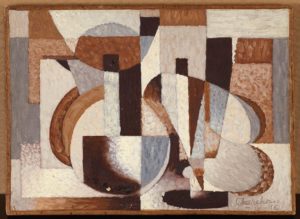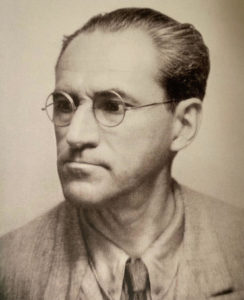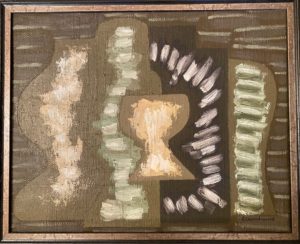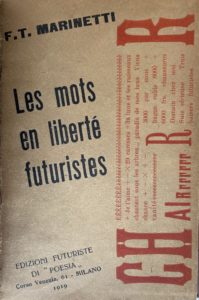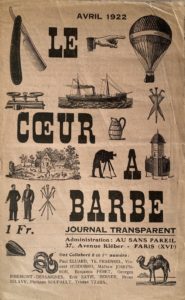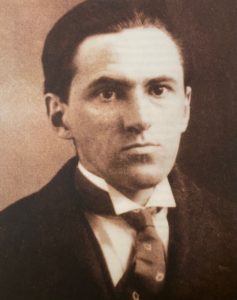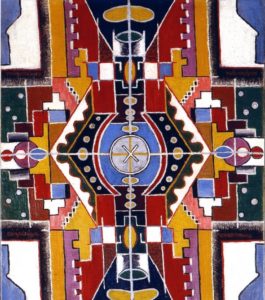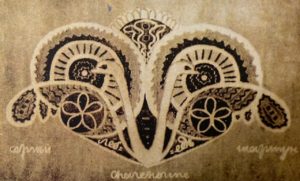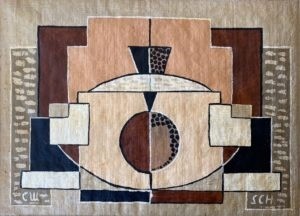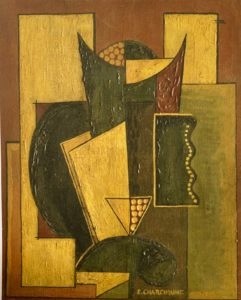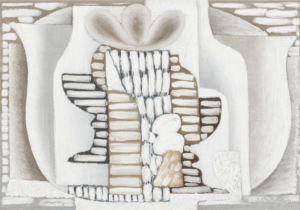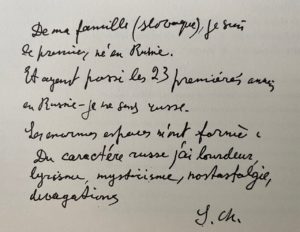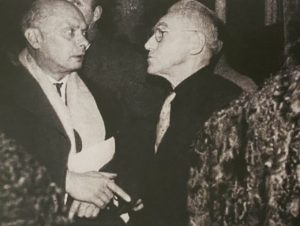It has been fourty-five years I met Serge Charchoune during a painter friend’s vernissage at the Berri-Lardy Gallery in Paris. That evening of 1974, one year before Charchoune’s death, I will never forget. I knew rather little about his painting at the time, but his character struck me. A withdrawn solitary being endowed with an impressive inner force, this is how he appeared to me at the time.
Thirteen years later, I opened my third gallery, Matignon Avenue and of course, the inauguration took place in 1987 with, for its first exhibition, a Charchoune retrospective.
Longstanding friend Pierre Brisset, art critic helped me by lending me a few major paintings. Pierre has liked Charchoune for a long time, he had written about him on several occasions with talent and humanity. In particular, he had particularly produced a text entitled « Charchoune the recluse » and still today, in spite of the various publications written since, it is undoubtedly one of the most beautiful writings both on the painter and the man who was Serge Charchoune. He told me again of his admiration for the painter and I suggested he write a few words about our mutual friend in order to present the exhibition. I held two Charchoune exhibitions in a row and this gave me the opportunity to make several encounters, with friends, collectors, and amateurs, people who had known him when he was alive.
These encounters stirred up my curiosity even more and made me want to go even further, this is why a few years later I started to write the catalogue raisonné of Serge Charchoune’s Paintings. This was colossal but enriching work. Three of the five projected volumes were published without counting the two other additional volumes of unindexed paintings. In the same way, if one is interested in Charchoune and his Purist period one cannot remain insensitive to Ozenfant’s painting, and it was logical for me to undertake, the catalogue raisonné of Amédée Ozenfant’s paintings. One cannot dissociate the two artists. Ozenfant by creating the Purist movement imprinted Serge Charchoune’s paintings and not only his painting but his way of thinking and living to the moste profound depths of his being.
Mais faisons connaissance avec l’homme et avec le peintre Serge Charchoune !…
Il est né le 4 août 1888 dans la province de Samara, à Bougourouslan, petite ville de la moyenne Volga sur les contreforts de l’Oural. Son père est slovaque et sa mère a des origines russo-polonaises. Les parents du jeune Sergueï tiennent un bazar où l’on vend des tissus de toutes les couleurs, des rubans et toutes sortes de choses. La mère, Matriona Ivanovna, meurt très jeune et le père a du mal à assumer son veuvage. Son fils, Serge, lui, n’est pas attiré par le commerce. C’est un mauvais élève et il s’intéresse davantage au dessin et à la peinture. Le père n’est pas enchanté dans un premier temps mais laisse tout de même son fils tenter l’entrée aux Beaux-Arts de Kazan. Serge échoue au concours, il ne dessine pas alors très bien et Ivan Mikhailovitch Charchoune envoie son fils à Moscou suivre des cours de dessin dans différentes académies. A Moscou il découvre au Musée Trétiakov les impressionnistes français, devient ami avec Larionov et sa femme Gontcharova. Petit à petit arrivent également à Moscou les peintres d’avant-garde, les fauves, les cubistes et les premiers peintres abstraits.
Serge Charchoune, it decided he wanted to be painter and only a painter. He felt a kinship with these new artists, also read a lot of the new Russian literature, and impassioned himself for music.
In 1910, a dramatic turn of events for Charchoune, the army required his service for three yeras. He then decide, in spite of all it implied, to desert and leave for Paris. He left Russia, passed through Poland, then through Berlin, and arrived in Paris in 1912.
« Hero straight out of a Dostoyevsky novel, he now had black and undulated hair. He was twenty-four and all filled with all the dreams of the world » one of his painter friends later said.
In Paris he enrolled at the Palette Academy attented by the Cubists. There he became acquainted with a woman sculptor, Helena Grünhoff, with whom he lived shottly after. Helena, older than Charchoune, has a strong personality. They lived in various studios, sharing the difficult life of young emigrated artists. This life was however rich in emotions and journeys. In 1914, war broke out and they both decided to leave for Spain to Barcelona where they joined other refugees wko presented them to Jose Dalmau Gallery which regularly exhibited Cubist paintings. In Spain Charchoune discovered the painted earthenware of the Azulejo, treasure of Hispano-Moresque art, which reminded him of the Byzantine ornamentations of the towns from his origins. He then started an important period in this work which he himself entitled : Ornemental ArtHe added gold or silver to the traditional colours and composed paintings are very beautiful and very hard to find today.
In 1916 Serge and Helena presented in Barcelona at the Jose Dalmau Gallery, their first solo exhibition : Helena Grünhoff, sculptures, Serge Charchoune, very symbolic Cubist and Ornamental paintings as well as his painted films whichn evoque cinema and movement, cinema he discovered in Barcelona. Charchoune baptized his creations as ornamental filmsThese paintings were perfectly accomplished and mix painting, ornament, decoration and cinema.
In this year of 1916 the parisian community grew with the arrival of Gleizes, Delaunay, Marie Laurencin. Charchoune became acquainted with Picabia at the Jose Dalmau Gallery, and took par in the review 391.
In 1917, Serge Charchoune got in touch with the Dada movement, held a new exhibition in Barcelona and went back to Paris with Helena. The André Forny bookshop organized in 1920 his first solo exhibition in Paris.In 1921 he published the only book he wrote in French Motionless Crowd that he illustred with six drawings.
Between 1917 and 1927 Charchoune experience ten intellectually rich years, he invested himself in the Dada movement thanks to Picabia, met André Breton, Tristan Tzara, Max Ernst, Eluard. One could be astonished by the participation in the Dada movement and to its lively evenings scandal-including. Serge Charchoune, a reserved, calm, even introverted boy, became on of the troublemakers of those insane nights of Montparnasse. Actually what interested him was the Dada movement’s constant questioning of traditional values, the will to make a clean sweep of middle-class behavior. In fact Charchoune drew the marrow from the Dada movement, nourished himself from it, contented in being as mush as possible a spectator and not completly an actor.
In 1922 he left with his companion for Berlin, founded the review Dada-Trans-ship, collaborated in Pressure Gauge, in Merz with Kurt Schwitters as well as the Dadaist review Mecano. He exhibited at the Der Sturm Gallery then at the Sarja Gallery where he became acquainted with Pougny. He produced in Berlin a whole series of important paintings that the even called : Ornamental Cubism. The range of colours subtly became darker ans the compositions are refined and well structured. This period in its production is also called the « Berlin period » and the small amount of paintings were all without exception of great quality. In Berlin he became acquainted with the dancer Isadora Duncan who ad returned from Russia where she had seen the horrors of the Bolshevik revolution which she recounted to her friends Serge Charchoune and Helena Grünhoff. Charchoune, who had intented to return to his country, was dismayed by Isadora’s remarks and gave up his project. Helena persisted in her wish to join post-revolutionist Russia ans left in spite of Isadora Duncan’s multiple warnings. Helena Grünhoff returned to the country of the Soviets, she was never seen again and nobody ever heard on her again.
In july 1923, Charchoune went definitlively back to Paris, remained a Dadais tat hear, carried out somme illustrations for the variou reviews but no longer took an active part in the movement. Helena’s disappearance disturbed him and so he renewed contact with the anthroposophy he had discovered in Berlin a few years earlier thanks to Rudolph Steiner. This system of thought interested him, this theory of reincarnation, this speculative research on man’s values in nature invaded him and influenced his work.
In 1926 the poet André Salmon was interested in his work, presented him to Jeanne Bucher who organized a very beautiful exhibition for him. He met Georges Waldemar who in turn presented him to a great amateur of Modern painting, scout of many talents, André Level, owner of the very important Percier Gallery in Paris. André Level bought many paintings from him and organized a solo exhibition for him in 1929. Salmon wrote the foreword for it. Moreover, Serge Charchoune met other prestigious artists at Level’s : Max Jacob, Picasso, René Rimbert, Gromaire. He became acquainted with Florent Fels, André Warnod, Wilhelm Uhde. Level had a profound frienship for Charchoune and always bought paintings from him, even in the difficult moments of the 1929 Economic Crisis.
In 1927 Nadia Leger presented him to Ozenfant. IT will be a key encounter and Ozenfant’s influence was felt at once. Founder of Purism with Le Corbusuer, Oenfant encouraged Charchoune, who was in turn attracted by this movement in which he found fundamental values, values that he had sought for a long time. Major works were born and Charchoune’s Purist period is for us the most beautiful amongst the artist’s painted pieces. Of his encounter with Ozenfant he later said : « I believe that I did not leave there unscathed ». Ozenfant’s contribution to art history was decisive. Both a painter and theorist, he was also pedagogical, his rigour impressed Charchoune, he established at the same time an aesthetic and philosophical vision as well as the major relations between man and the world. That same year Charchoune exhibited at the Aubier Gallery. Ozenfant wrote the foreword in these terms : « Charchoune, I have been given seven lines to describe you. I would prefer five words, Il would say : you have nobility, and that should be enough to draw the attention of the connoisseurs to these crystalline or warm, discrete, melodic, sensitive and intelligent lines. One can only reach this by being endowed with the doubly combined talent that the God of Art grants parsimoniously : force and finesse. You are lucky Charchoune. I only wish amateurs to be lucky to hear me in time ».
The years 1925 to 1929, the Purist years, regroup as we underlined major works in the painter’s production. Indeed when some paintings from this period are analized, simplicity and purity of form, succesfull compositional technique, refined mastery of colour are found together. All this is expressed either on plain and smooth surfaces or this matter laid out with a brush or knife, or on surfaces with a structured refief. Flat planes of colour with delicate nuances are juxtaposed with objects painted in relief with a knife and this gives thespectator a subtle marriage, alternating strenght and softness, foreground and depth, calm and strength, rest and storm.
During this mature period, Charchoune completely controlled the chromatic pallet, the art of glacis and thick brushstrokes. During these years he took part in important and numerous exhibitions. In 1926 he wa summoned by Marcel Duchamp to exhibit at the Société Anonyme. In 1927, Van Doesburg integrated him in his « Selection of Contemporary Artists » in Strasbourg. In 1929, he carried out another exhibition at the Percier Gallery. Picasso who was present at the vernissage, encouraged him and bought one of his paintings.
Succes from then on a given, his art dealer André Level also encouraged him and the sales he made during this exhibition finally brought him a certain material comfort. Admittedly he was not rolling in the money as one says but he could then regalarly buy large-sized canvases on which his art could finally be expressed completely. Mendès-France, director of the Percier Gallery, supported him. Ozenfant was admiring and testifield his frienship to him by his puchases and letters.
Unfortunately the 1929 Economic Crisis upset everything and did not spare the Art Market, many artists found themselves unable to sell a single painting, many galleries closed, the others tried to survive. At the beginning of the thirties, Charchoune lived in great destitution. He gave up Purisme and tried various pictorial experiments mixing Dada with various research. The Elactic Landcapes were born, the figurative appeared intermingled with abstrac compositions. It was the series of landscapes, windows.
This period of searching and sadness lasted ten years, during which Charchoune lived in the greatest misery. Returning then to the very firs years of his youth, Serge Charchoune returned to writting, generally desperate poema in Russian and sometimes in French. He says many years later : « I tried to turne, in vain, to every side, inevitably I was going against my own statue. Literature, writing, are for me a genuine relief ».
Charchoune then met Louis Rimbault, anarchist, founder of « Terre Libérée » which preached the return to one’s sources, the return to the earth, the return to healthier food. He involved Serge in a Community experiment in Touraine, a vegetarian community where everyone received a small holding, produced their own vegetables and lived very withdrawn within the community while rejecting that one would today call the consumer society. After a few months, Charchoune returned to the capital, registered himself with the « aid for artists », which enabled him to survive almost ten years, until the beginning of the Forties.
He was forgotten by all remained alone in these difficult years, recluse, proud, withdrawn, no longer believing in mankind thought he wa but forty years old : « the rest of the world does not concern me ; external events can sometimes touch me but they never hold me at my throat…Yes I know many people, I have shaken many hands but I do not have any friends ».
At the beginning of the 1940 War, Serge Charchoune met the Livengood couple, he American, she Dutch, from an old family of Art and dealers. They regularly bought paintings from him. Charchoune finally left misery behind. He rented a workshop in cité Falguière and started living again through his painting. Edwin Livengood was a long-time friend of Level and via the two men Charchoune became acquainted with the great art lower Roger Dutilleul and Jean Bauret, businessman and collector. These two amateurs bought many of his paintings and became close friends with Serge Charchoune.
Charchoune painted still lifes, geometrical compositions, in which the colours often merged in the same dominant theme thanks to the inclusions of Pointillist spots.
In 1944, Charchoune broke off with the Livengood. Serge Charchoune met a young at dealer, Raymond Creuze, who benefitting from the disgreemants withe the Livengoods, proposed to take him in his gallery. He exhibited there for a dozen years, multiplying solo exhibitions. The paintings however did not sell easily but enabled him tobe entirely to his production and live modestly. Charchoune went to concerts when he could, read a lot and painted while listening to Beethoven or Brahms.
Music, like water, was a constant fascination for Charchoune. It was in 1944 that he painted his first paintings of musicalor instrumental inspiration. The violin was his first mode of inspiration, in the two years which followed he painted a whole series of still lifes with violin, cello, banjo. In parallel he returned from time to time to Purism through the workshop’s various objects : bowls, cups, bottles, spoons and forks.
In 1948, he started the very beautiful period of the marine cycles, often with great elaborate very constructed compositions. In 1956, he reclaimed his freedom again and left the Creuze gallery. Pierre Brisset, a great critic who wrote a lot about Charchoune, brought us a few years later the testimony of his first visit to the artist’s workshop : « When a dozen years ago, I went to visit him for the first time in his workshop of the cité Falguière City where Modigliani and Soutine had lived before, he had hardly emerged from the voyage to the end of the night that he had begun some thirty years before ! Misery still ooze from everywhere, a misery not shameful but accepted, clean, meticulous. A white wool table, three stools and a nasty bed discretely hidden behind a curtain of coarse ecru canvas, such was all his furniture which was enough however to invade on its own, this tiny space. One did no walk, one slipped, one crept by taking care not to disturb the fragile ordinance ».
At the time the artist devoted himself almost exclusively to the musical theme. Very large formats appeared, thus allowig him, certiginous conductor, to break out all his emotion. In 960, he settled in Vanves. Beethoven, « my conducteur he says, inspired him like his other companions : Mozart, Schubert, Bach. The great compositions followed. He met his last art dealer Jean-Louis Roque who also organized several solo exhibitions for him.
In 1971, the National Museum of Modern Artorganized the first great Serge Charchoune retrospective. Jean Leymarie paid a well-deserved homage to him in the exhibition catalogue. The sameyear the Jean-Louis Roque Gallery also paid hoge to him and Pierre Brisset then Wrote a very moving text about the artist and his work. From this date on the exhibitions succeeded one another : Geneva, Paris, Rheims, Cannes, Milan welcomed Charchoune.
In 1974, Charchoune left on a journey, still fascinated by the sea , to the Galapagos Islands ; during this voyage he has his malaise and had trouble returning in spite of several stops.
In 1975, he died alone in Villeneuve Saint-Georges, a few very close friends attended his burial at the Russian Sainte Geneviève des Bois cemetery. He left an opus of several thousands paintings. His paintings are presented from now on in many museums through the world, as well as in largest collections.
